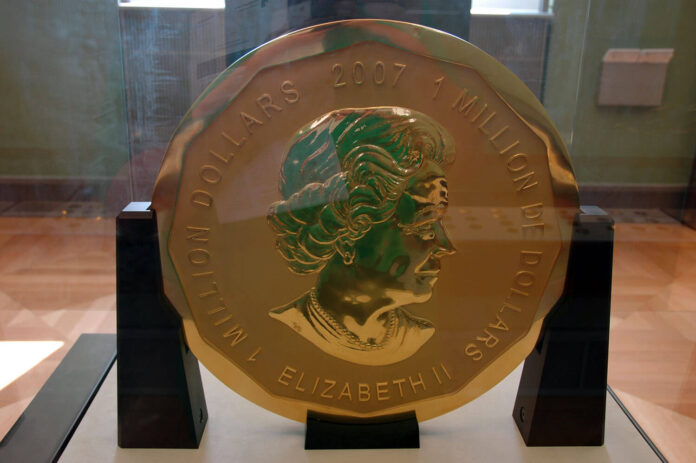
A major mistake when beginning to collect coins is to believe that the face value is the coin’s actual value. This might be true regarding circulation coins, but if a coin is made of silver or gold, you’d better ignore the face value altogether as its actual material value is many times that amount. For example, the American Gold Eagle has a face value of 50 dollars, but its material value is about $2,000. Instead, you should focus on the weight and the fineness of a coin because, together with the current precious metal price, these figures enable you to get a realistic idea about the coin’s material value. And then there is a piece’s value to collectors, which is obviously not easy to quantify and can depend on many factors. As an example, let’s take a look at the Big Maple Leaf gold coin that was stolen in 2017 – because there are some new facts about this case.
Is 100 Kilograms of Pure Gold Only Worth 1 Million Dollars?
At this point, you probably do not need us to lay out the basic facts about this case anymore. (If you do: here you can find our previous articles on the matter.) The stolen gold coin had an impressive face value: the legend read “1 MILLION DOLLARS” – meaning, of course, Canadian dollars, which would currently equal about 680,000 euros. That’s not bad – however, the coin was made of 100 kilos of pure gold. Thus, the coin’s material value was around 4.2 million euros at the time of the theft. And that is the very amount this coin was insured for before its owner, an art collector from Düsseldorf, loaned it to the museum in Berlin. In this case, one could certainly assume that this coin is of even higher value to collectors given that the piece is one of only 5 specimens and stands out due to its exceptional size. It is impossible to say whether this was taken into account when they determined the sum insured.

Who Will Pay?
The thieves that stole the coin only cared about its material value. As far as we know, the coin was cut into pieces, melted down and sold in the form of gold bars. Although the perpetrators have been caught and convicted by now, one question remains: who will pay for the damage? The coin was not the property of the Prussian Cultural Heritage Foundation, which runs most major Berlin museums including the Numismatic Collection and Bode Museum. The coin was owned by a private citizen who does not really benefit from the fact that some young men will now have to spend four years in prison – his coin is still gone. Who will pay for the damage, the insurance company or the foundation? That isn’t an easy question, no one likes to take the blame and the obligations that come with it. The collector commented in an interview with Süddeutsche Zeitung: “My problem is that I am caught between two stools because neither the museum nor the insurance company are willing to change their position. I would prefer it if they sorted things out on their own, because I have the least responsibility for all this. My coin is gone and I haven’t received any money either.”
He received some money after all, but it wasn’t much: the insurance company found that there were serious safety deficiencies on the part of the foundation, which is why they only covered 20% of the sum insured, 840,000 euros (as you can read in CoinsWeekly).
The owner was not pleased about that. (Who would be?) He took legal action to make the insurance company pay an additional amount, but lost at the Berlin Regional Court in 2020. However, he did not give up. On 26 May 2021 he achieved a partial success in the next instance.

A Gross Breach of the Duty to Notify
The Berlin Kammergericht, the highest state court of Berlin, dealt with the appeal of the owner, who was joined in this matter by the Prussian Cultural Heritage Foundation as an “intervening party in the proceedings on the plaintiff’s side” – a step the foundation certainly did not only took for altruistic reasons.
The court confirmed the serious omissions on the part of the foundation, and held that these omissions justified a reduction in payment by the insurance company. The court’s press release on the trial contains interesting details on the matter:
“The Prussian Cultural Heritage Foundation, the policyholder, had been grossly negligent in failing to report an increase in risk (…). The malfunction of the casement windows in the men’s changing room in the Bode Museum was an increase in risk that had to be reported. This malfunction led to the fact that the electronic security monitoring system was no longer working properly as it constantly indicated an alarm due to an open window in that room. For this reason, the window in the men’s changing room had been removed from the opening protection system enabling the museum to put the alarm system including the opening protection system back into operation, at least for the other rooms. This situation made it more likely that someone might break into the museums with the purpose of stealing the coin, and the malfunction had not been compensated for by other measures. (…)
The 6th Civil Senate of the Kammergericht is therefore convinced that the defendant would not have concluded an insurance policy with this specific content if they had known about the permanent deactivation of the opening protection system regarding the window in the changing room.”
And there is another complicating factor: the museum knew about the security gaps but did not do something about it for years and did neither report them to the owner of the coin nor to the insurance company.
“The particularly gross breach of the duty to notify (…) is due to the fact that the Prussian Cultural Heritage Foundation did not report the increase in risk for years after the problem occurred in 2014. Thus, the period for notification of the increase in risk had already expired for a long time when the insured event occurred in March 2017. The defendant, on the other hand, had not been aware of this increase in risk until the insured event occurred, he had only become aware of it when they dealt with the insured event after March 2017.”
The Foundation’s guilt was thus confirmed. The court ruled that the insurance company was allowed to reduce the claim amount, however, only to 50%, which means that the insurance company must now pay 2.1 million instead of 840,000 euros. Whether the insurance company accepts the verdict is still unclear.
A Fatal Message
The verdict was thus a partial success for the owner, who wanted the insurance company to pay 3.34 million euros. That’s at least something. However, this means that as matters stand he would still lose half of the sum he insured – he, the lender who is least responsible for what happened and regarding whom this is about private assets. That is a fatal message that will certainly prevent some private lenders from allowing museums to display their objects in the future. We don’t know yet whether the owner will try to have the foundation, which is organised under the auspices of the federal government, to pay the remaining 2.1 million euros. The court’s findings regarding the serious security issues seem to make this imaginable. Moreover, we learn from the judgement that the foundation itself is the policyholder. It therefore seems strange that the owner has to fight for his compensation with the insurance company.
Finally, to return to our question about the value of the coin, one more thing should be stated: even if the owner were to receive the entire sum insured amounting to 4.2 million euros, this would merely equal its material value from 10 years ago. Today, its material value would be much higher, about 5 million euros…
You can find all our articles on the Big Maple Leaf here.
Here you can read the court’s press release on the ruling.



